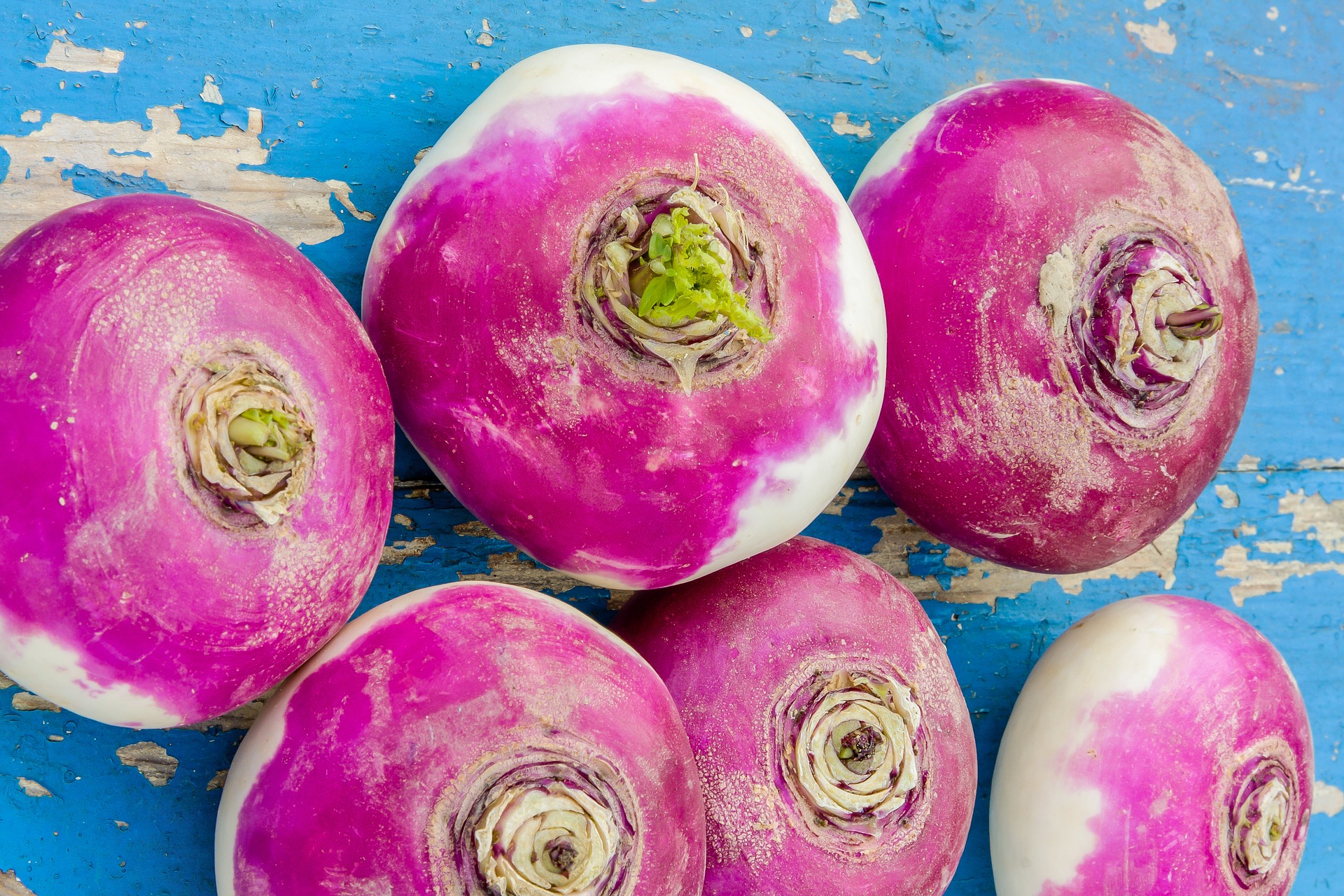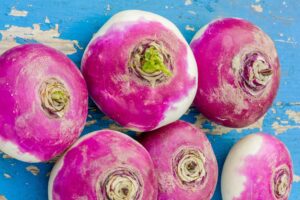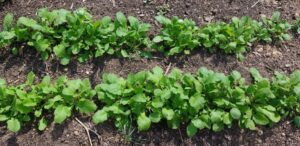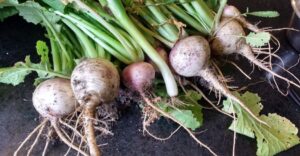I was in my thirties before I ate a turnip and enjoyed it. They started showing up in mass quantities in my CSA basket. I decided I had to do something other than compost them. I went to the internet and found a suggestion to roast them and use them as a potato substitute in recipes.
Turnips are the New Potatoes?
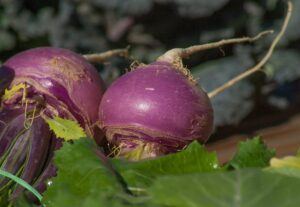
Image by jacqueline macou from Pixabay
Although the history of turnips is not well-documented, in Europe and parts of Asia, turnip cultivation likely preceded that of potatoes by a few thousand years. That means there’s a good chance that potatoes were once the new turnips in parts of the old world.
Today, turnips are being re-popularized as a healthy, new alternative to potatoes. Despite the irony of turnips as the new potatoes, there are good reasons to consider adding them to your diet and garden.
1. Delicious and Versatile
Incredibly, with just a little caramelizing and crisping of the skin, something that previously tasted like spicy dirt can quickly become a dinner favorite. They can be used boiled and mashed, hashed, creamed in soup, roasted with other root vegetables, and more.
When grown in ideal conditions and harvested young, turnips are exceptionally tasty raw. Serve them julienne-style in salads or with Asian noodle dishes in lieu of carrots. Slice them thin, seasoned with a squeeze of lemon juice and cracked pepper, and offer them up as a turnip carpaccio.
All of those methods taste amazing. My personal favorite way to eat my turnips, though, is fermented. Just grate your turnips, add a 2% of their weight in salt, and toss in some caraway seeds. Then, use your favorite fermenting vessel to transform turnips into sauerreuben in just a week or so.
2. Nutritious Cancer Prevention Food
Also, with their high glucosinolate (GLS) quantities, like other cruciferous vegetables, turnips are believed to be an excellent cancer prevention food.1)https://journals.plos.org/plosone/article?id=10.1371/journal.pone.0217862 Add to that their low calorie, high-fiber, high vitamin C content and turnips turn out to be an excellent choice for good nutrition too.
Just a cup of cooked, cubed turnips has 34 calories, 3.1 grams of fiber, 1.1 grams of protein, and 30% of your daily vitamin C needs.2)https://nutritiondata.self.com/facts/vegetables-and-vegetable-products/2700/2
3. Other Potential Health Benefits
A round up of the available research on turnips, over the last 20 years, also concluded this.
The major active constituents of turnip are glucosinolates, isothiocyanates, flavonoids and phenylpropanoids which showed diverse bioactivities, including antioxidant, anticancer, antimicrobial, antidiabetic, hepatoprotective, nephroprotective, cardiovascular and hypolipidemic, analgesic and anti‐inflammatory effects constituents. 3)https://onlinelibrary.wiley.com/doi/full/10.1111/1750-3841.14417
I don’t know about you, but turnips seem like pretty potent super food to me. Unfortunately, as with most foods that have potential as an easy to use and effective preventative medicine, little research exists on real life impacts in the body. However, given the promising information from the crude compound studies performed to date, this list of possible benefits is probably the tip of the iceberg for all the good in those glorious globes and edible greens.
You may also enjoy:
10 Incredibly Powerful Antiviral Herbs
15 Natural Antibiotic Alternatives
Can You Eat Enough To Be Healthy?
4. Easy to Grow
Turnips are also quite easy to grow in cool weather. They tolerate a wide range of soil quality and pH ranges. They have some drought resistance. Plus, they can even withstand a few frosts.
5. Livestock Fodder
Did I mention that turnips also make a great livestock fodder? Forage varieties will out-compete weeds, don’t even need to be drilled to plant, and grow to grazing size in under two months.
6. Soil Benefits
Similar to mustard, turnips may also be beneficial as a soil biofumigant. According to that same round up of research mentioned earlier, those antimicrobial benefits might also extend to fungal pathogens and nematodes pest problems in the soil.
Not enough research has been done to fully comprehend the soil benefits of planting turnips. However, the little bit available has convinced me that growing turnips as part of my normal crop rotation is a good idea.
When I harvest turnips for roots, I now leave behind any uneaten greens as a green manure. Also, any roots that get woody before I get to harvest them, are left behind to decompose in the soil similar to a tillage radish.
Read More: Mustard Greens: What You Need to Know Before You Grow (With Recipe)
A Few Cautionary Notes
Before you go all in on trading turnips for potatoes, or planting up your pasture with them, there are a few things you need to know.
Livestock Research
Most of the research on turnips relates to their use as a highly palatable, high protein, fast-growing livestock fodder. The above-ground greens have crude protein in the 20-25% range which is high for non-legume animal fodder.
The edible roots also provide starches and fiber beneficial to livestock. The fact that they can start early and grow late in the season makes them an attractive fodder. Yet, they are not a good single source kind of fodder for a couple of reasons.4)https://hort.purdue.edu/newcrop/afcm/turnip.html
– Goiter
In livestock animals, over consumption of turnips can lead to goiter issues. Those same GSLs that make turnips an awesome anti-cancer choice can contribute to enlarged thyroid glands when over-used.
– Anemia Risks
Also, S-methyl cysteine sulphoxide (SMCO), another substance present in turnips can lead to anemia in livestock. Livestock are at greater risk for anemia than your average healthy, well-fed human due to the prevalence of internal parasites in herds. So, when you add in too much SMCO, turnips could be problematic.
Safe Use
At least in animals, the key to making good use of turnips without negative impacts boils down to quality and moderation. Although there’s no particular research on this in humans, I suspect a similar approach is beneficial in humans.
As such, here are a few things to think about.
Ideal For Eating
GSLs are what make all plants like mustard, cabbage, and radishes in brassica family taste bitter. Though always present, GSLs becomes stronger as plants age. Those GSLs also become more volatile in plants that face severe pest or pathogen challenges.
The GSLs in turnips are believed to become more volatile when the plants are under increased pest pressure. The theory is that the plant volatizes the GSLs as a protective mechanism to discourage pests from eating its leaves and roots.
Younger turnips, under 60 days in age and those grown in ideal conditions with fewer pest issues, likely have less volatile compounds. As such, they may pose less potential risk for toxicity than old, ill-grown turnips.
Humans like pests, don’t usually love the taste of GSLs gone volatile. The bitter, burning sensation are a bit of a turn off. Most grocery store turnips taste that way to me, which is probably why I never liked them until they came young and frsh in my CSA.
The easiest way to assure high quality in your turnips is to grow your own. Also, make sure they are part of a balanced diet of many colorful, varied foods.
Growing Turnips
Turnips must be grown in cool weather. If you grow them in warm weather, they will be bitter, pest prone, and slow-growing. Even with all those delicious eating ideas I covered earlier, no preparation in the world will make a poorly grown turnip taste like a reasonable potato substitute. So, trust me on this – turnips are a cool season crop. Temperatures ranging between 40-78°F (4.5-25.5°C) are best.
Depending on which variety you choose, bulbs mature in 40-60 days. Fortunately, that means that in most climates you can find a window wide enough to grow your own turnips. Baby turnips can also be grown in about 30-50 days. So, even if you can’t get big bulbs, in your climate, you may be able to get a tiny turnip crop.
Soil Preparation
Turnips will grow in terrible soil, so long as it’s not boggy. However, they will taste entirely better and grow faster in ideal soil. Well-draining, soil rich in organic matter that is at least 8-10 inches deep is best.
Turnips are good gleaners of many nutrients. Other than compost and a little residual fertilizer from earlier planted crops, turnips don’t need much fertilizer for good production.
In boron-deficient soils, you may need to add trace amounts of boron for healthy, tasty turnips. If you’ve have instances of clubfoot or slow-heading cabbages, then check your boron with a soil test before planting turnips.
I also add a sprinkle of bone meal, or other slow-release phosphorous source, to the root zone before planting. Phosphorous is static in the soil. If you don’t have it nicely situated in the 3-4 inches under your turnip root, then it can be hard for your turnip roots to access. That may slow production.
Seed Starting
Turnips germinate quickly as soon as the soil reaches 55-60°F (13-15°C). It usually only takes a few days of regular watering to trigger germination in those conditions. Then you can water every few days until plants are a couple inches tall.
Direct planting in well-prepared beds is the best method for starting seeds. However, starting turnips in soil blocks or individual cells also works. Don’t ever using the plucking out method of transplanting for turnips. The roots must not be disturbed during transplanting.
Plant spacing depends on soil fertility. I have fertile soil that I’ve been working on for the last 6 years. I plant 8-10 turnips per square foot. However, when I had poor quality soil, I spaced them on 6 inch centers so plants had sufficient access to nutrients.
Turnips grow fast. Leaves can get to a foot tall in under a month in good conditions. Let your growth rate be your guide. If your greens aren’t several inches off the ground in a couple of weeks after germination, thin more plants by trimming and eating the greens. Then, add a little fertilizer such as compost tea or fish emulsion to restart growth.
Plant Care
As long as the basic growing conditions are ideal, the only really care required in growing turnips is weekly watering if there’s insufficient rain. You may need to do a little weeding early on. Generally, though, the fast growth rate of the greens tends to crowd out weeds.
Don’t over water turnips. The part we consider the root is actually a meeting of the stem and root tissue. The above-ground portion is at risk for rot if the top inch of soil remains wet. Ideally you want good moisture content in the root zone, but slightly dry soil at the surface.
Read More: 7 Keys to Good Water Management in the Organic Garden
Turnip Greens Versus Roots
If you harvest greens from your root turnips, then the plants think you are a pest. That triggers the release of those volatile compounds we covered early.
Because turnips are biennials and need to experience a period of mild cold to set seeds, they’ll send most of those volatile compounds to the turnip storage root. That way even if herbivores eat the leaves, the root will still be safe and can survive long enough to put up more greens, flower, set seeds and reproduce.
In simple terms, if you harvest greens from your turnips grown for roots, you are more likely to have bitter tasting roots. To avoid that risk, grow some plants for roots and others for greens. Or, harvest your roots young and then also use the roots at the same time.
Varieties
Incidentally, there are also some varieties of turnips that were specifically bred for green production instead of root production. This is similar to the way that chard is a beet bred for its greens while beets are bred for root production.
Seven Top is the most common heirloom turnip green variety. Purple Top White Globe is the most common heirloom root variety. However, there are many other options from heirloom and hybrid seed producers. Just make sure you pick those that match up to your goal of roots or greens.
If you have known problems in your area with turnip mosaic virus, then focus on varieties with some resistance to the strains in your environment.
Unconventional Tips
If you are one of those people that like to experiment in the garden, turnips are a fun vegetable to use for taste trials. In my garden, I’ve tried growing them in various mediums such as compost only or soil mixes. I’ve used different amendments such as minerals, granite dust, gypsum. I’ve played with using shade to cool the soil. Ive planted at different times of year. Of course, I’ve also tried all sorts of varieties.
My best flavor profile is fall grown, with bone meal, and no harvesting of leaves. But, my experiments have also taught met that I can get nearly the same results in spring if I start a little early using row covers and finish the last bit of growing using a little afternoon shade from taller plants like sunflowers once spring heats up. Pure compost, as long as it is well-balanced and long-aged, also works as well as soil mixes for great flavor.
Read More: The Organic Growers Tool Kit Series
Dish the Dirt On Turnips
Do you have any turnip epiphanies or eating experiences to share? Do you love them or hate them? Have you grown turnipts at various times of the year or in different climates? Do you have any favorite varieties?
Our community would love to hear from you too! Please leave your comments for your fellow TGN members to follow.

Tasha Greer is a regular contributor to The Grow Network and has cowritten several e-books with Marjory Wildcraft. The author of “Grow Your Own Spices” (December 2020), she also blogs for MorningChores.com and Mother Earth News. For more tips on homesteading and herb and spice gardening, follow Tasha at Simplestead.com.
